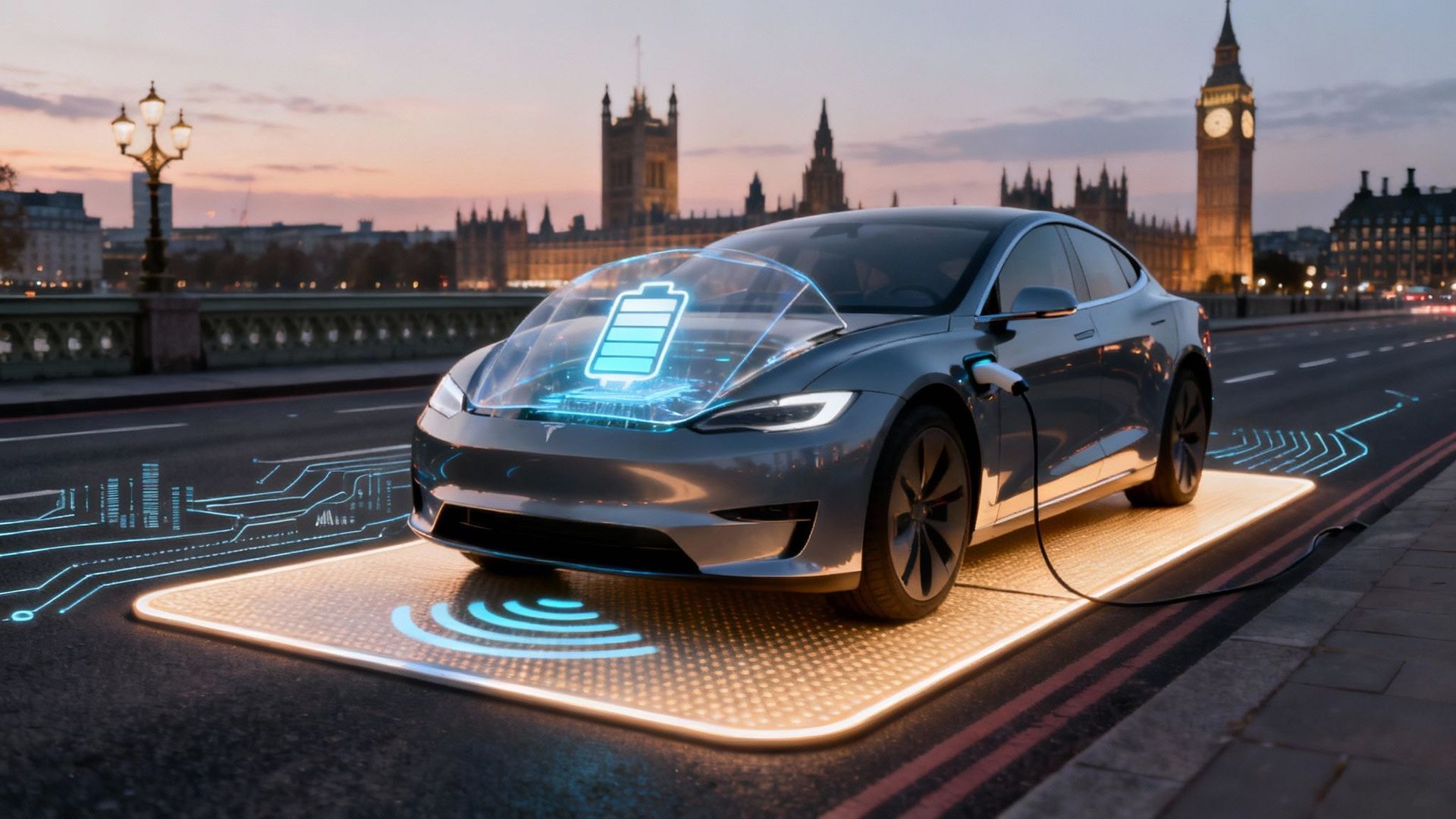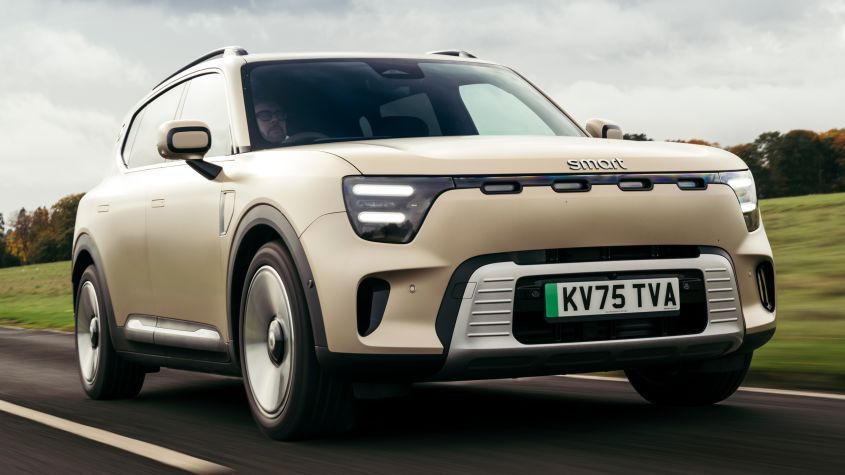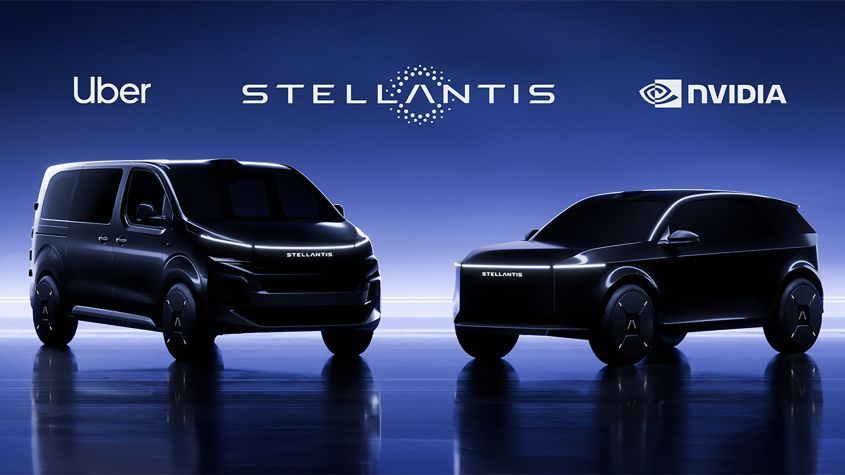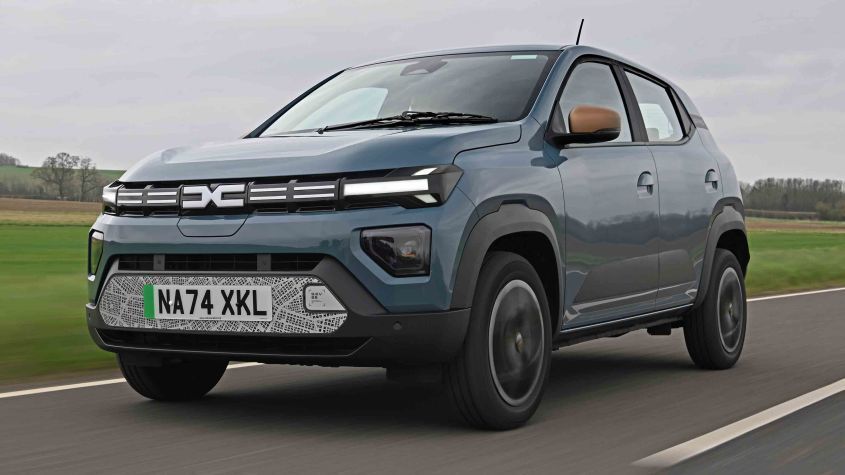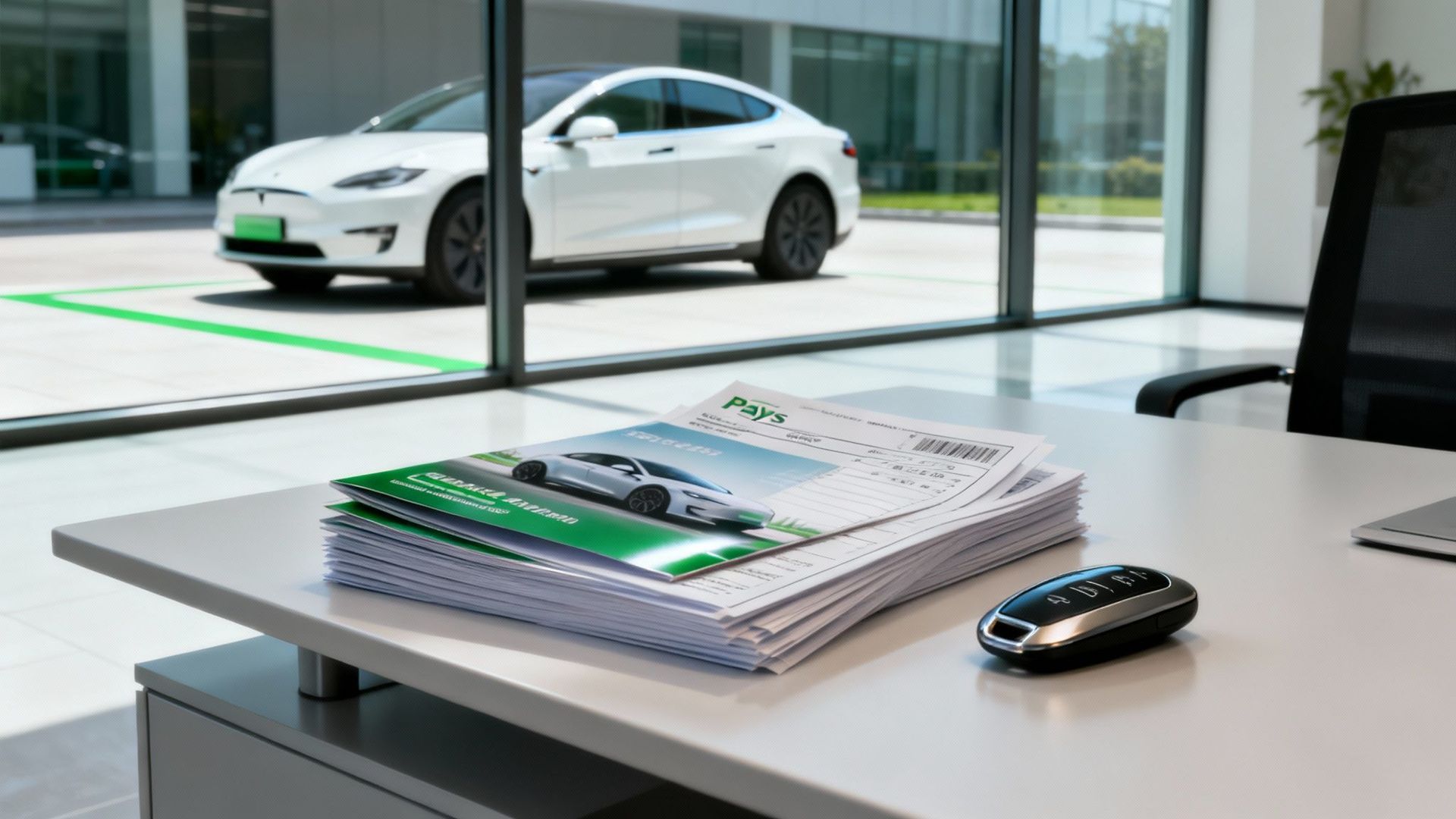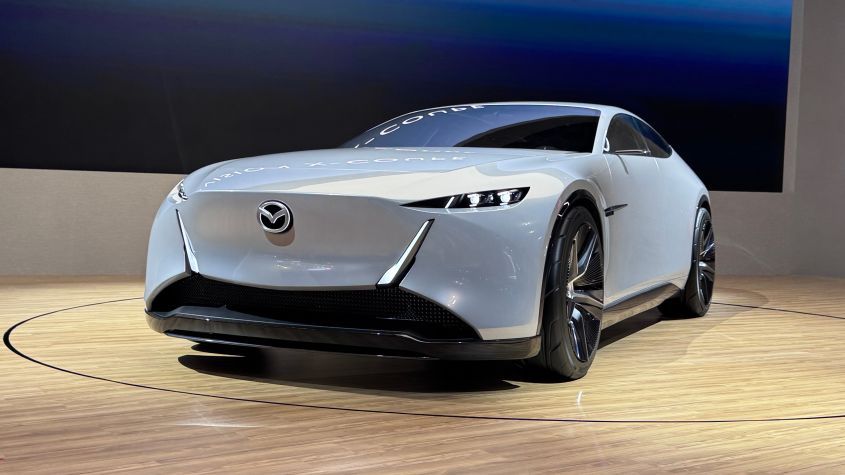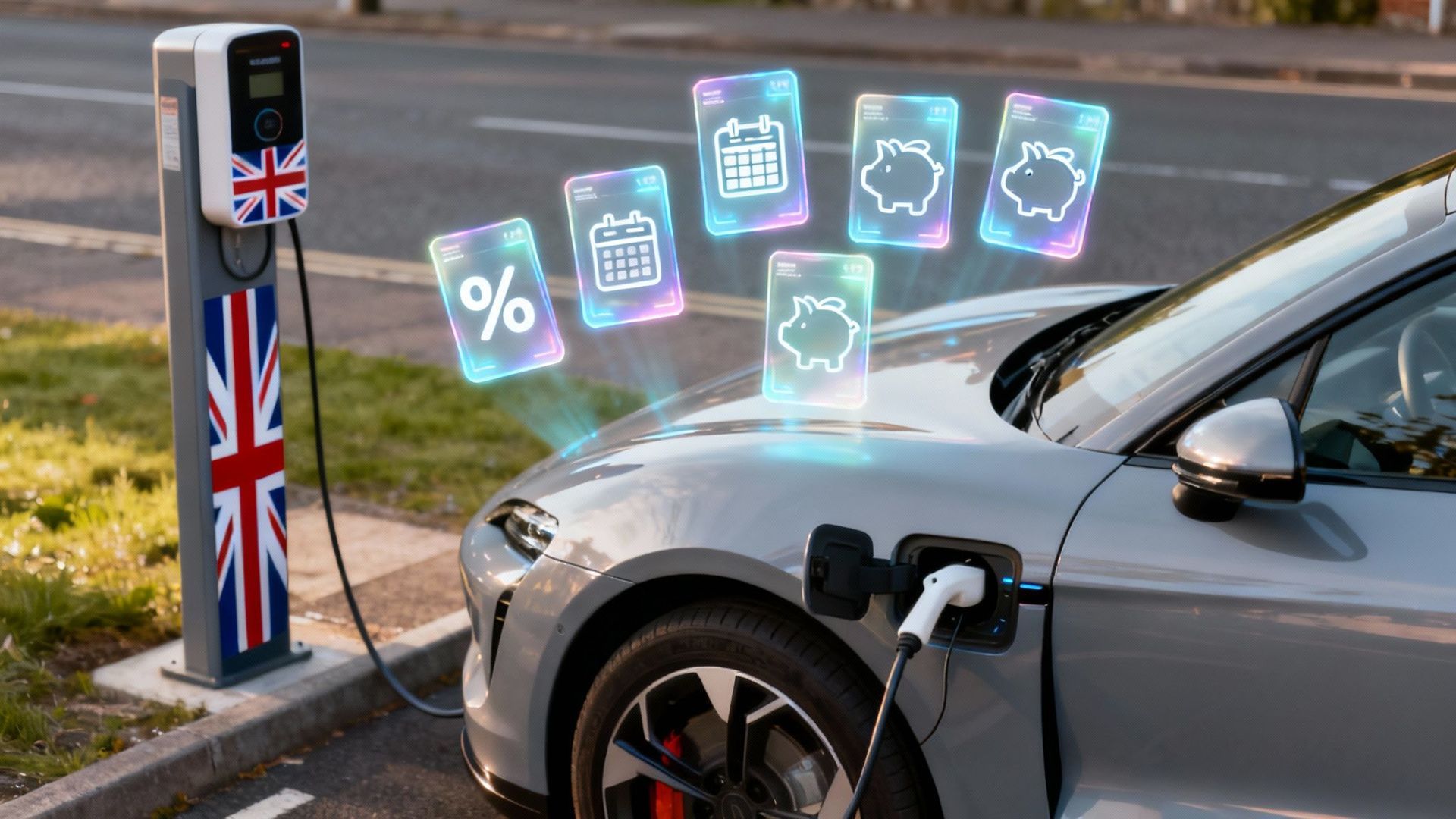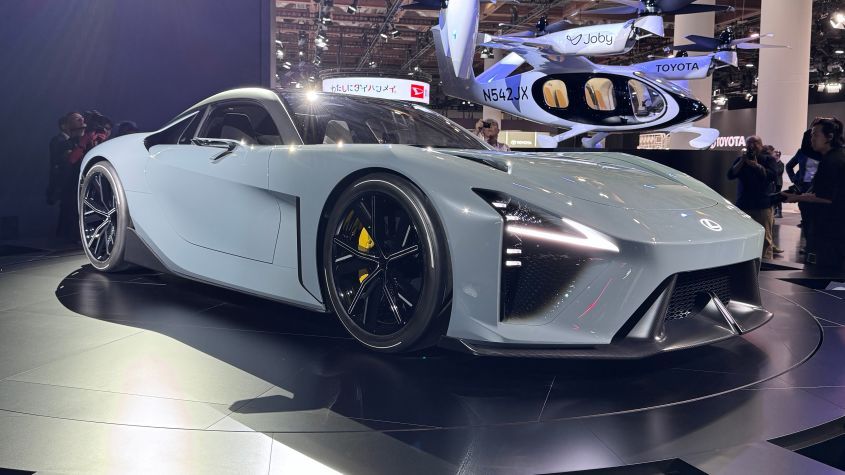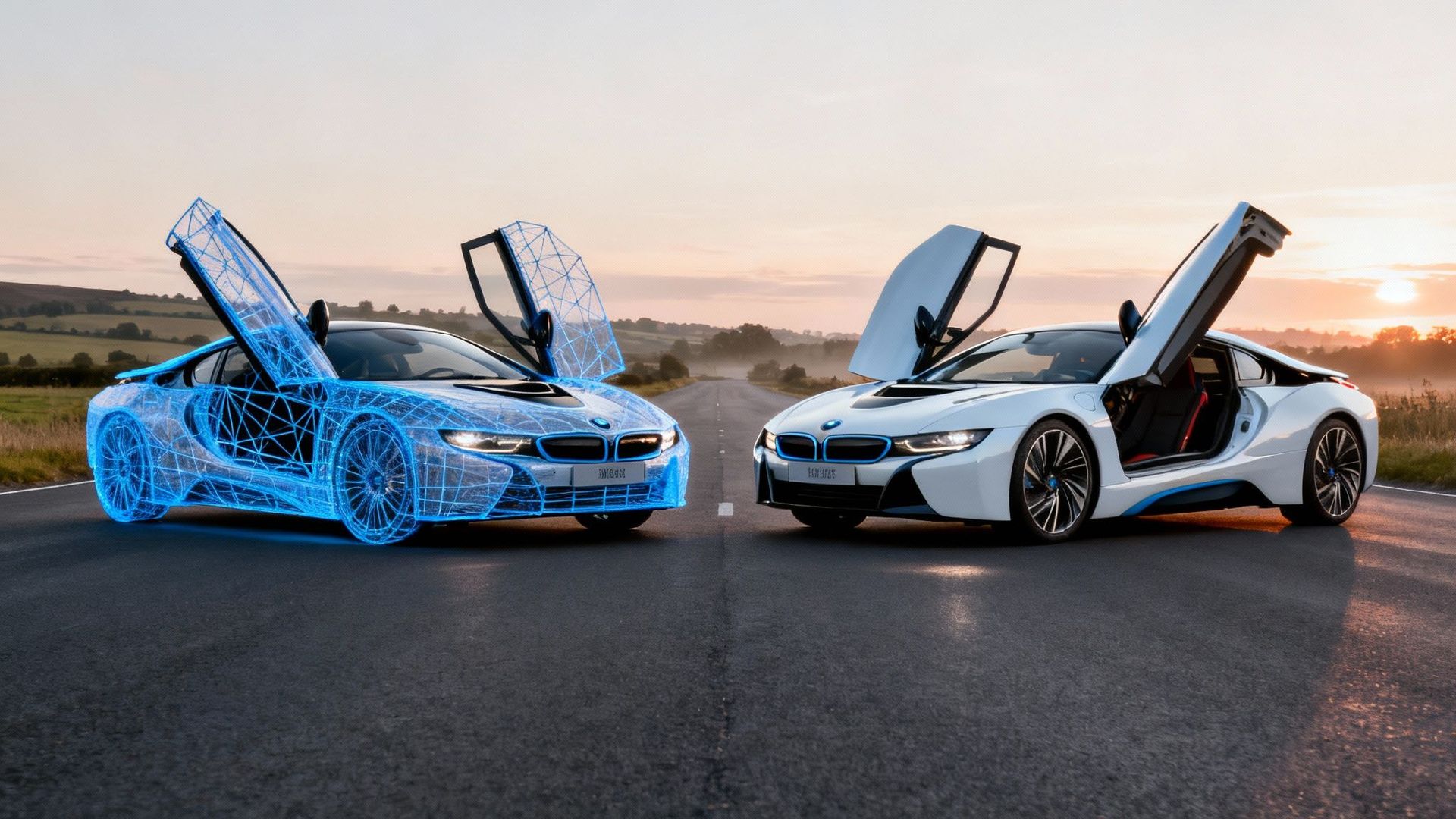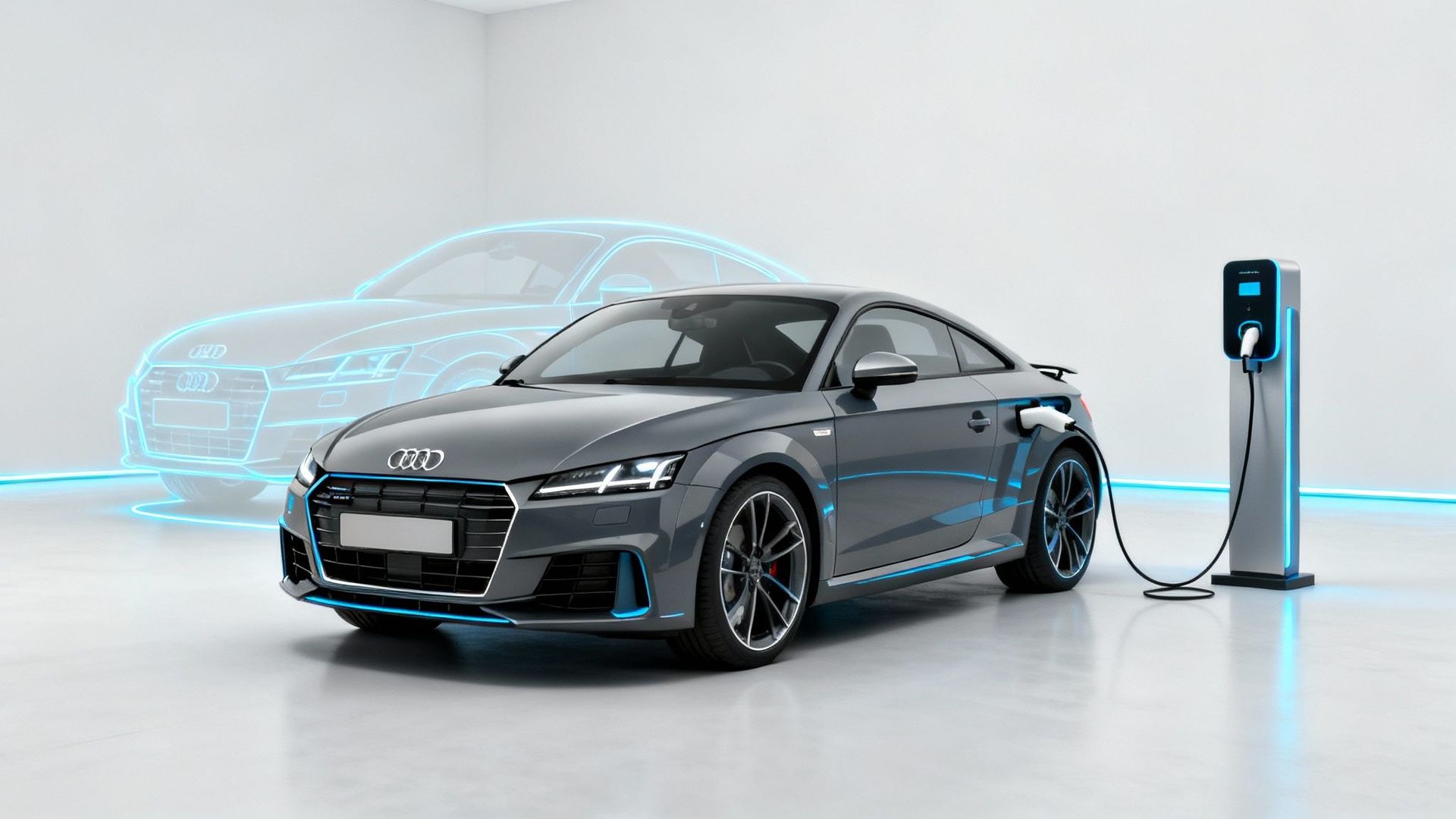UK Guide to Electric Commercial Vehicles
Let's be honest, the idea of swapping your trusty diesel Transit for something that plugs into the wall can feel a bit like trading a proper fry-up for a kale smoothie. It sounds virtuous, but is it actually any good? The short answer is a resounding yes – electric commercial vehicles are fast becoming the smartest financial decision for UK businesses, not just some green-washed vanity project.
Your Business Needs To Go Electric Sooner Than You Think
Swapping your diesel-guzzling workhorse for a silent, battery-powered alternative feels like a massive leap. For years, the whole idea was frankly laughable—a niche for city councils wanting to look good and delivery firms with more money than sense.
But the ground has well and truly shifted. What once seemed like a distant, eco-friendly fantasy is now a cold, hard business reality. This isn't just about saving the polar bears; it's about saving your bottom line.
The simple truth is that the traditional commercial vehicle is on borrowed time. With the government’s ban on new petrol and diesel van sales looming, sticking with the old ways is like insisting on using a pager in the age of the smartphone. It might feel familiar, but you’re just getting left behind.
The Real Reasons To Switch
This shift isn’t being driven by a sudden corporate conscience. It's about brass tacks—money, efficiency, and future-proofing your entire operation. Sticking your head in the sand is no longer a viable strategy when the benefits of making the change are this clear. The momentum is building, and the reasons are piling up.
Here’s a brutally honest look at why this is happening right now:
- Dodging Punitive Charges: Clean Air Zones (CAZs) and the Ultra Low Emission Zone (ULEZ) are spreading like wildfire across UK cities. Every day you drive an older diesel into one is another day you’re paying a penalty for the privilege. An electric van, on the other hand, sails through these zones for free, turning a daily expense into a direct saving.
- Slashing Running Costs: Forget the eye-watering prices at the diesel pump. Charging a van overnight at your depot or home costs a fraction of what you’d spend on a full tank. Throw in the near-total absence of road tax and significantly lower maintenance bills (no oil changes, fewer moving parts), and the financial case becomes impossible to ignore.
- The Perk of Silence: Ever tried to make a 6 AM delivery in a quiet residential street with a diesel engine clattering away? Electric vans are whisper-quiet. This means happier neighbours, less stress for your drivers, and the genuine ability to operate at unsociable hours without causing a massive ruckus.
The transition to electric isn’t just an operational upgrade; it’s a strategic move. Businesses that adapt now will gain a significant competitive edge over those who wait until they are forced to change.
What's more, a modern fleet of electric vehicles sends a powerful message to your customers. It says you’re a forward-thinking, efficient, and responsible business. For a deeper dive, you can learn more about how electric vehicles are revolutionising fleet management and making operations smarter. This isn't just about changing your fuel source; it's about changing the game entirely.
Understanding The Different Types Of Electric Vans
Right, let's clear something up. When we talk about 'electric commercial vehicles', we're not talking about a milk float with delusions of grandeur. The market has exploded, and thinking all electric vans are the same is like assuming a spanner and a socket wrench do the same job. They don't. And picking the wrong one will leave you looking like a proper wally.
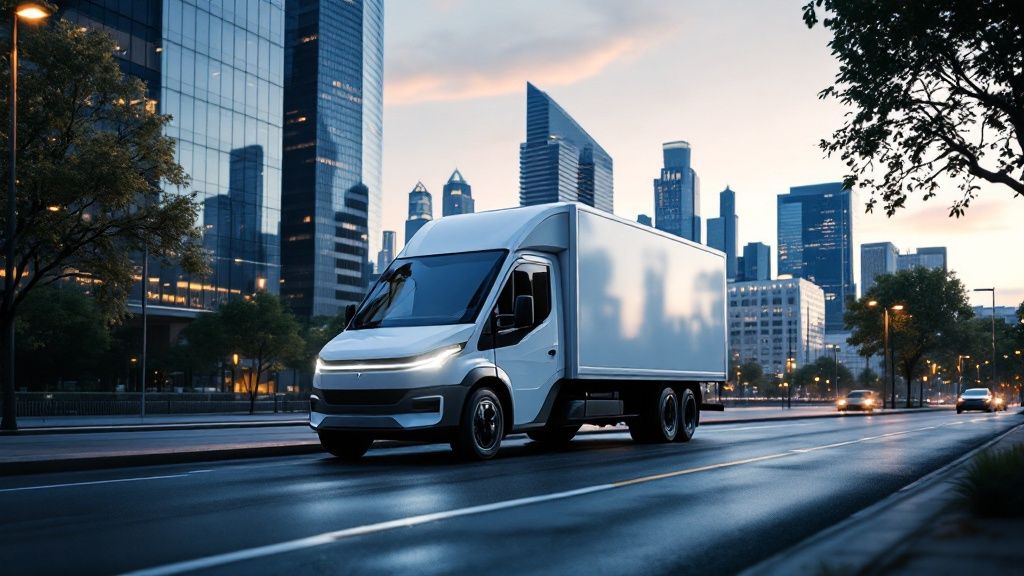
Before you part with your hard-earned cash, you need to understand the fundamental differences. It all boils down to matching the vehicle's capabilities—its size, battery, and payload—to the actual demands of your business, not some fantasy scenario where every job is five minutes from the depot.
Small Vans: The City Slickers
Think of these as the nippy terriers of the van world. Often derived from cars, like the Renault Zoe Van, they’re designed for zipping through congested city streets, delivering flowers, artisan bread, or anything else that doesn't weigh a tonne.
Their small size is their superpower. They can squeeze into tight parking spots and navigate narrow lanes that would give a Transit driver a nervous breakdown. The trade-off? A smaller battery and a more modest payload. They’re perfect for local multi-drop work but ask one to haul bags of cement up the M1 and it'll have a strop.
Medium Panel Vans: The All-Rounders
This is where the market gets serious, featuring a rogues' gallery of familiar names like the Ford E-Transit Custom and the Vauxhall Vivaro Electric. These are the workhorses of Britain, the backbone of tradespeople and delivery fleets up and down the country.
They offer a brilliant compromise:
- Decent Payload: Enough capacity to handle most daily jobs without groaning under the weight.
- Realistic Range: Their larger batteries are designed to last a full working day, provided you're not driving like you've nicked it.
- Practicality: Big enough for plasterboard and tools, yet still manageable in a supermarket car park.
This category represents the sweet spot for a huge number of businesses. They are the versatile multi-tool you'll find yourself reaching for day in, day out. Getting this choice right is vital.
Large Panel Vans: The Heavy Lifters
Now we’re in big boy territory. These are the hulking beasts of burden, the electric equivalent of a long-wheelbase Sprinter or Ducato. They’re built for one thing: swallowing enormous amounts of cargo. Think house moves, large-scale deliveries, and trades that require a mobile workshop's worth of kit.
Their massive size allows for equally massive batteries, giving them some of the best range figures in the game. But be warned, their sheer bulk makes them a nightmare in tight urban environments, and they require more thought when it comes to charging infrastructure. You can't just plug one of these into a domestic socket and hope for the best.
Choosing the right size is the first, and most important, decision you'll make. It dictates everything else: your daily range, your running costs, and ultimately, whether the van is a useful tool or an expensive, impractical ornament.
While the van market is electrifying at a steady pace, the bigger end of town is still playing catch-up. In 2025, a mere 1% of new heavy goods vehicles sold in the UK were zero-emission models. However, with the government aiming to phase out new diesel trucks under 26 tonnes by 2035, the push is well and truly on. You can discover more insights about the rise of electric HGVs on Gridserve.com. This gradual shift shows that while adoption is still in its early days, the direction of travel is clear for all commercial vehicles, big and small.
The Pros, Cons, And Realities Of Electric Vans
Right, let's get down to brass tacks. Anyone trying to sell you an electric van by talking only about saving the planet and silent running is either a charlatan or has never had to find a working charger on a wet Tuesday in Stoke. The switch to electric commercial vehicles isn't all sunshine and ULEZ-free motoring. It's a calculated gamble with genuine upsides, infuriating downsides, and a few plain truths you need to face with your eyes wide open.
This is the warts-and-all look at the reality of running a battery-powered workhorse. Forget the marketing fluff; this is the stuff they don't put in the brochure.
The Glorious Upsides
Let's start with the good stuff, because there’s plenty of it. The most glorious, undeniable pro is the liberation from the tyranny of the diesel pump. Watching fuel prices yo-yo while you're smugly plugged in overnight is a feeling that never gets old. Electricity isn't free, but compared to diesel, it might as well be.
This financial relief extends well beyond just fuel:
- Tax Vanishes: Say goodbye to Vehicle Excise Duty. That’s a chunk of change straight back into your pocket, every single year.
- Service Bills Shrink: Electric vans have far fewer moving parts than their rattly diesel cousins. No oil changes, no filters, no exhaust systems waiting to rust through. This means less downtime and cheaper maintenance bills.
- City Zones Are Free: Navigating the ever-expanding web of Clean Air and Ultra Low Emission Zones becomes a stress-free affair. You can sail through city centres without paying a penny, a saving that can amount to thousands a year for busy urban fleets.
The Grinding Downsides
Of course, it can't all be good news. The biggest, most unavoidable con is the initial purchase price. Electric vans are eye-wateringly expensive compared to their diesel equivalents. Even after you’ve navigated the bureaucratic maze of government grants, you're still looking at a significant premium.
The core decision boils down to this: are you willing to swallow a hefty upfront cost to unlock significant long-term savings? For many, this initial hurdle is simply too high.
Then there's the charging palaver. While overnight charging at a depot is straightforward, relying on the public network is a national sport combining the frustration of a traffic jam with the excitement of a lottery. Finding a charger is one thing; finding one that isn't broken, occupied, or inexplicably slow is another challenge entirely.
Diesel Drudgery vs Electric Freedom: A No-Nonsense Comparison
To really see the difference, you have to look beyond the big-ticket items and think about the day-to-day grind. Here’s how the old ways stack up against the new.
| Consideration | The Old Diesel Clunker | The Sparky Newcomer |
|---|---|---|
| Morning Routine | Praying it starts on a cold day, a deafening engine clatter, and that lovely puff of black smoke. | Unplug and go. It’s quiet, smooth, and ready for work instantly. |
| Running Costs | A constant drain. Diesel, AdBlue, oil changes, VED... the list goes on. | Cheaper ‘fuel’ from the plug, minimal servicing, and zero road tax. |
| Driving in Town | A nerve-wracking game of "Am I in the CAZ?" Constant gear changes and engine noise. | Blissfully simple. Cruise through city centres without a fee or a care. |
| On-the-Road Hassle | Hunting for a petrol station, grimacing at the price on the pump. | Planning routes around public chargers. Will it be working? Will it be free? |
| Payload Impact | Not a major concern. The engine's power is fairly consistent. | A big factor. A heavy load and cold weather can really eat into your range. |
| End-of-Day Feeling | Ears ringing from engine drone, smelling faintly of diesel fumes. | More relaxed. The quiet, vibration-free ride makes a genuine difference. |
As you can see, it's a trade-off. The electric van offers a much more pleasant and cheaper day-to-day experience, but it demands more planning and a different mindset, especially when it comes to charging and range.
The Cold Hard Realities
Beyond the simple pros and cons lies the day-to-day reality of living with an electric van. The advertised range is, to put it mildly, a work of fiction. It's a figure achieved in a lab, on a warm day, with no load, driven by a saint. In the real world, chuck a full load in the back, turn the heater on during a cold snap, and watch that range plummet by 20-30% .
Furthermore, while government incentives are a major selling point for electric commercial vehicles, it's worth noting how these vary globally. The following chart illustrates the average government subsidies available in different major markets.
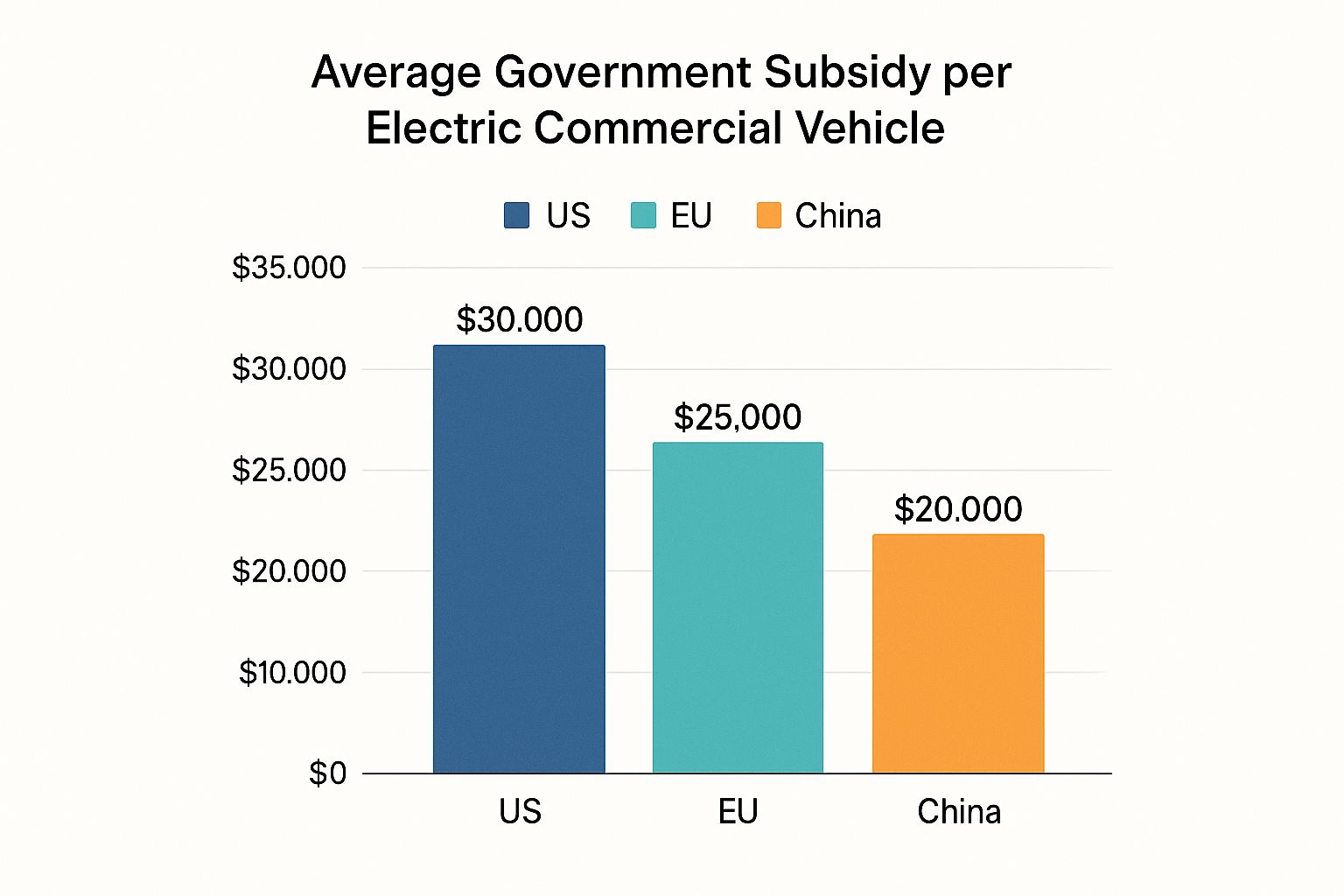
This data shows that support levels differ significantly, which can influence how quickly businesses in each region can offset the high initial cost. The reality is that while the UK's Plug-in Van Grant helps, the initial financial sting remains sharp.
Another reality is battery health. All batteries degrade over time, losing their ability to hold a full charge. Modern EV batteries are proving remarkably robust, with an average degradation rate of just 1.8% per year , but it's a factor you must consider. A van that can comfortably do 150 miles when new might struggle to hit 120 after eight years of hard graft. It’s an unavoidable aspect of the technology that requires a long-term mindset. Making the switch is a commitment, not just a purchase.
A Look at Britain's Best Electric Workhorses
Right, that’s enough of the theory. Let's talk about the actual metal—the electric vans you can buy, drive, and inevitably spill tea in. We're not here to just spit back the glossy brochure specs or get poetic about panel gaps. This is a proper, no-nonsense look at the key players fighting for your business, judged on what really matters: can it do the job without causing you a headache?
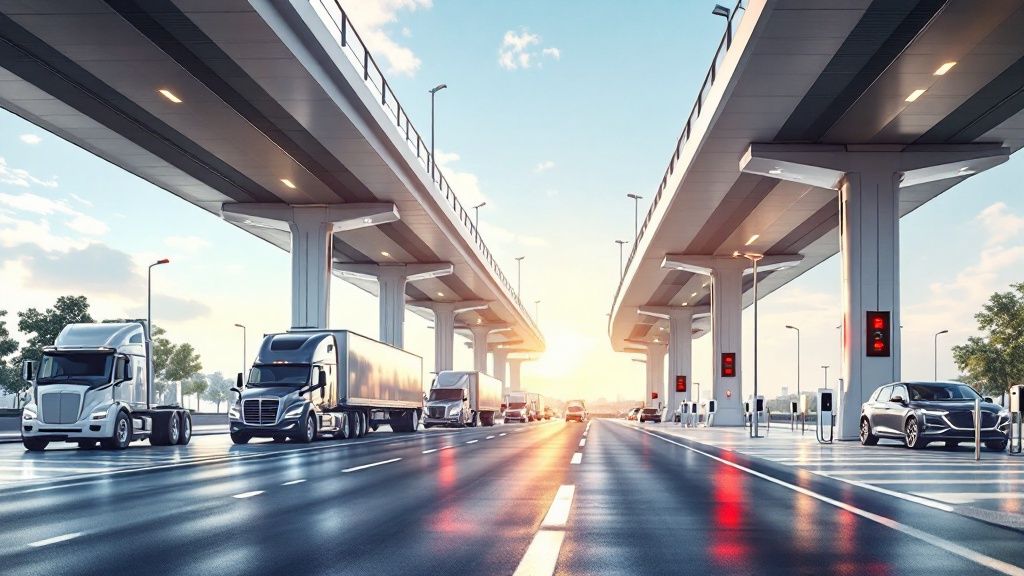
We'll be sizing up these workhorses based on three simple, real-world criteria. First, what’s the actual range, not the fantasy figures? Second, how practical is the payload? And third, is the cabin a decent place to scoff a pasty during a downpour? Think of it as a chat about vans down the pub, but with slightly more accurate data.
The UK's roads are getting quieter as these electric workhorses steadily become a more common sight. As of mid-2024, there are over 1,145,000 fully electric cars on the road, with nearly 315,000 of those registered in 2023 alone. While the initial buzz from private buyers might have cooled slightly, it’s fleet buyers who are really pushing things forward. That means the next van you see is increasingly likely to be electric. You can dig into the numbers behind this remarkable rise in EV adoption on The Eco Experts.
So, which ones are actually worth your time and money?
The Undisputed King: Ford E-Transit Custom
Let's start with the big one. The diesel Transit has been the backbone of British trade for decades, and Ford knew they couldn't mess this up. Thankfully, they haven't. The E-Transit Custom is, to put it plainly, brilliant.
It drives with a sharpness that no van has any right to possess and is loaded with genuinely useful tech. More importantly, its advertised range is one of the most honest in the business. Ford claims up to 209 miles , and while you won't hit that with a full load of bricks and a headwind, it consistently delivers a usable daily range that won't leave you with a case of range anxiety.
- Pasty Verdict: The cabin is top-notch. It’s spacious, thoughtfully designed, and features Ford's clever tilting steering wheel that transforms into a perfect little table for your lunch or laptop.
- The Catch? It’s a Ford Transit. It’s excellent, but it’s also as common as rain in Manchester. You’ll never stand out from the crowd.
The Sensible Choice: Vauxhall Vivaro Electric
If the Ford is the shiny new tool everyone wants, the Vauxhall Vivaro Electric is the trusty old hammer that just gets the job done, day in and day out. It’s part of a huge family of almost identical vans from the Stellantis group (including the Peugeot e-Expert and Citroën ë-Dispatch), which means the platform is well-tested and parts are easy to come by.
It’s not exciting, but it works. You get a choice of two battery sizes, with the larger 75kWh version offering a respectable official range of over 200 miles . In the real world, you're looking at 160-170 miles on a good day. It boasts a strong payload, and its compact size makes it a breeze to navigate through tight city streets.
The Stellantis vans are the vanilla ice cream of the e-van world. They won't set your pulse racing, but they're a dependable, crowd-pleasing option that rarely disappoints. A safe bet for any business.
The cabin, however, does feel a bit dated and plasticky next to the Ford. It's perfectly functional, but you wouldn’t want to spend hours doing paperwork in it. Think of it as a workspace, not a mobile office.
The Dark Horse: Maxus eDeliver 9
Who? You might be asking. Maxus, the brand that rose from the ashes of LDV, has been quietly producing some seriously compelling electric vans. The eDeliver 9 is their large panel van offering, and it’s a direct challenger to the full-fat Ford E-Transit.
What makes it a real contender is its sheer value for money and the huge choice of battery options. You can spec it with a battery all the way up to 88.5kWh , giving it one of the best potential ranges in its class. At its core, it's a big, no-frills box on wheels designed to swallow cargo and cover distance with minimum fuss.
- Pasty Verdict: The cabin is basic but functional. You'll find plenty of hard plastics, but it all feels tough enough to handle the rough and tumble of a proper working life.
- The Catch? The badge doesn't carry the same weight as Ford or Mercedes, and the driving experience is more 'functional' than 'fun'. But if you care more about load volume per pound, it’s impossible to ignore.
Navigating Government Grants and Incentives
Ah, government grants. The carrot dangled to make an eye-watering investment feel a little less painful. Let's be honest, the initial outlay for an electric commercial vehicle is steep, and the government knows it. That's why these incentives exist—to give businesses a nudge towards a greener fleet.
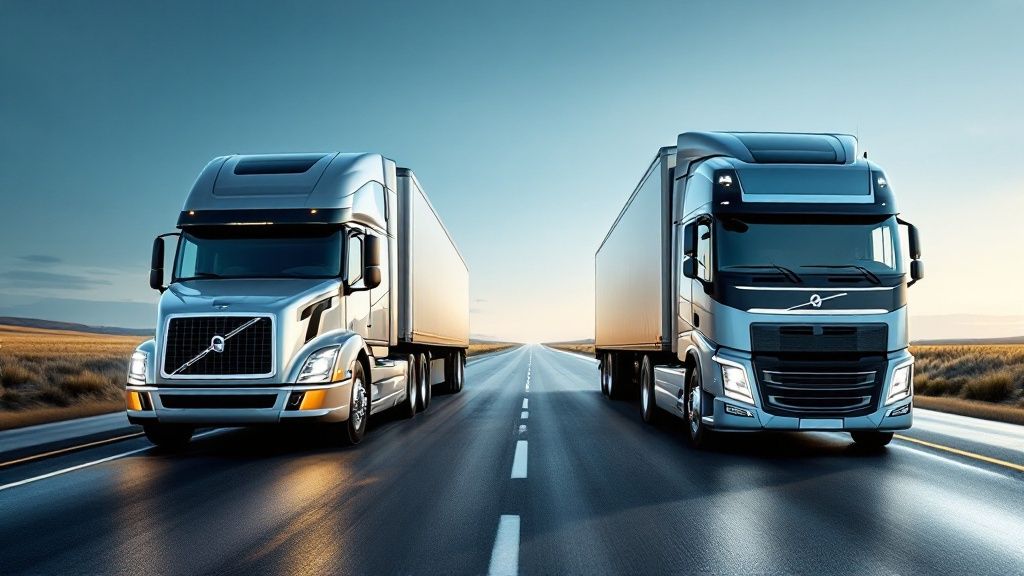
Think of it less as free money and more as a calculated discount to soften the initial financial blow. Getting to grips with this system is your first real challenge as a prospective electric van owner, long before you start worrying about finding a working charger on the M6.
Decoding The Plug-in Van Grant
The headline act in this financial support package is the Plug-in Van Grant . While the grant for electric cars has vanished, the government has, for now, kept its wallet open for businesses making the switch. It’s a crucial bit of help, but don’t go expecting a blank cheque.
The scheme is neatly divided into two tiers, based on the van's weight:
- Small Vans (under 2,500kg gross vehicle weight): You can get 35% off the purchase price, but this is capped at £2,500 . It's certainly better than nothing, but it won't drastically alter the final figure.
- Large Vans (2,500kg - 4,250kg gross vehicle weight): The discount is still 35% , but the cap is raised to a more helpful £5,000 . On a larger, more expensive vehicle, this makes a much more noticeable dent in the price.
The best part? You don't have to wade through piles of paperwork. The dealer handles the application and deducts the grant at the point of sale, so the price you're quoted is the price you pay. Just double-check that your chosen model is on the government's approved list, otherwise you'll get zilch.
Don't Forget The Taxman's Generosity
Beyond the upfront discount, some of the most significant savings come from the tax benefits, courtesy of HMRC. These are the long-term perks that really start to stack up, making the total cost of ownership incredibly attractive.
If you’re lucky enough to have a work van that you can also use personally, the tax situation is almost too good to be true. The Benefit-in-Kind (BiK) tax rate for electric vans is currently 0% . That’s right—you pay absolutely no company van tax for that privilege.
This is a massive saving compared to the hefty tax bill you'd face for doing the same with a diesel equivalent. It's a powerful incentive that can save drivers hundreds, if not thousands, of pounds every year. On top of that, the cost of installing charging points at your business premises can often be written off against your corporation tax bill.
Of course, what the government gives, it can also take away. It's worth remembering the car grant was scrapped, and it's not a huge leap to think the van grant might eventually follow suit. For a slightly more cynical take, you can read our thoughts on why the UK government's EV grant being gone is no big deal for the passenger car market. The smart move is to make the most of these incentives while they're still on the table.
The Smart Money: Finding A Nearly-New Electric Van
Let’s be honest, brand-new electric commercial vehicles come with a hefty price tag. For most small businesses, the initial outlay is enough to make you wince. But what if you could lock in all the perks—the rock-bottom running costs, the ULEZ exemption, and that satisfyingly quiet hum—without the eye-watering cost?
That’s where the smartest corner of the electric van market comes in: nearly-new models. This is where the real value lies, and it’s the perfect way for a business to cut its fuel bill without having to take out a second mortgage.
The logic is beautifully straightforward. Let someone else absorb the biggest financial hit. The second a new van is registered and driven off the forecourt, its value takes a nosedive. By targeting an ex-demonstrator or a lightly-used model with just a few thousand miles under its belt, you neatly sidestep that brutal initial depreciation.
The Sweet Spot: A Lightly-Used Renault Kangoo E-Tech
A one-year-old Renault Kangoo E-Tech from a main dealer is a perfect example of this sweet spot. You're looking at a van with maybe 5,000-10,000 miles on it, so it's barely even run in. It probably still has that 'new van' smell, and crucially, the majority of its original 8-year battery warranty is still active.
So what's the deal? You get a van that feels brand new, a huge discount on the list price, and the security of a manufacturer's warranty. The market for electric vans is still maturing, and that creates opportunities for savvy buyers. In the first half of 2025, new commercial van registrations across Europe dipped by 13.2% due to various market factors. You can read more about these commercial vehicle registration trends from ACEA. This slight slowdown can make dealers even more motivated to shift their nearly-new stock with attractive deals.
Buying a nearly-new electric van isn't about being cheap; it's about being clever. You're getting 95% of the new-van experience while letting the first owner pay for the steepest drop in value. It’s the ultimate financial two-fingers to depreciation.
When you take one for a spin, keep an eye on the range indicator after a full charge and make sure all the charging cables are included. For a more detailed checklist, our guide on the top 5 things to inspect when buying a used EV will walk you through everything you need to know to make a smart, confident purchase.
Common Questions About Electric Commercial Vehicles
Right, let's tackle those nagging questions you've probably been pondering but might have been too polite (or embarrassed) to ask. When it comes to electric commercial vehicles, there's a world of difference between the glossy brochure promises and the grim reality of a wet Wednesday on the A303. Here are some straight answers to the most common queries.
How Long Does It Actually Take To Charge?
Forget what the marketing department tells you; charging time is a proper "how long is a piece of string" affair. It really boils down to two things: the charger's power and your van's battery size.
- A Standard 3-Pin Plug: Utterly pointless for anything other than a desperate, emergency trickle. You'll be waiting for more than 24 hours for a full charge on most vans. Best to avoid it.
- A 7kW Wallbox (Home/Depot): This is your bread and butter for overnight charging. Expect a full charge to take anywhere from 8-12 hours , meaning your van will be fully juiced and ready to go every morning.
- A 50kW Public Rapid Charger: The saviour for a mid-day top-up. This will get you from a nearly empty 20% to a very useful 80% in about 45-60 minutes . Just enough time for a proper brew and a bacon butty.
Will A Heavy Load Completely Kill The Range?
In a word: yes. Just as a diesel van guzzles more fuel when it's weighed down, an electric van's battery will drain much faster with a full load. It's crucial to remember that manufacturers' official range figures are calculated under ideal, often completely empty, conditions.
As a cynical rule of thumb, take the advertised range and immediately knock off 20-30% for real-world driving with a decent payload. If you're hammering it down the motorway in the dead of winter with the heater on full blast, expect that figure to drop even further.
Are The Batteries Reliable?
This is the big fear, isn't it? The thought of a multi-thousand-pound battery giving up the ghost is enough to make anyone nervous. Thankfully, complete battery failure is exceptionally rare.
What does happen is gradual degradation—the slow loss of its ability to hold a full charge over time. Modern batteries are proving impressively durable, losing on average just 1.8% of their capacity per year. To put your mind at ease, virtually all manufacturers offer a separate battery warranty, typically for 8 years or 100,000 miles . This guarantees the battery will retain a certain percentage of its original capacity (usually 70% ), protecting you from premature failure. The replacement cost is steep, but it’s a problem you're very unlikely to face in the typical ownership lifespan of a new van.
At VoltsMonster , we cut through the noise to give you the real story on electric vehicles. For more brutally honest reviews, guides, and industry chat, check out our latest articles and videos at https://www.voltsmonster.com.


